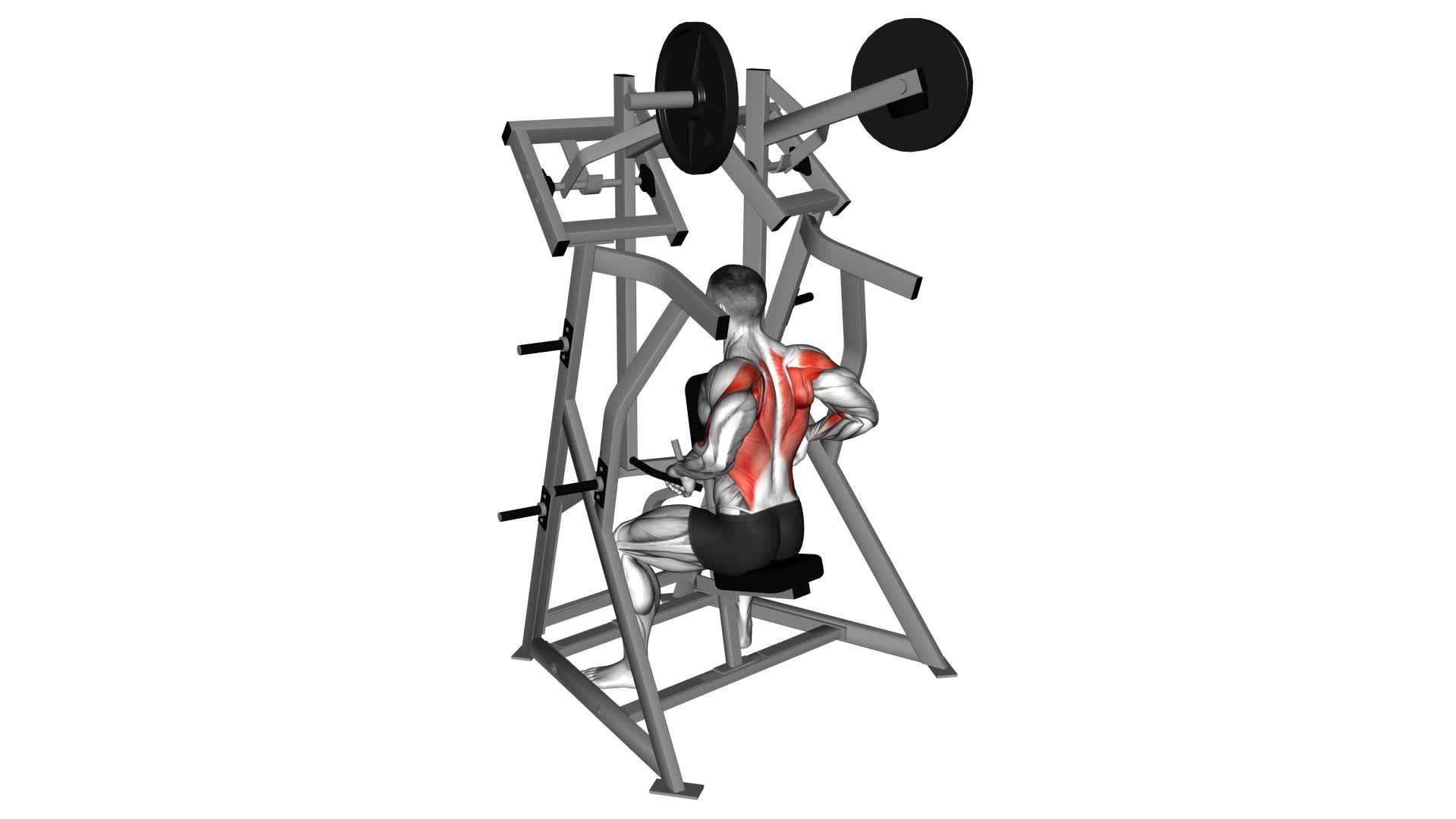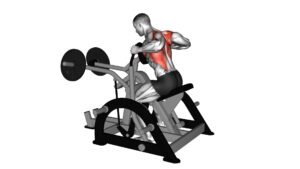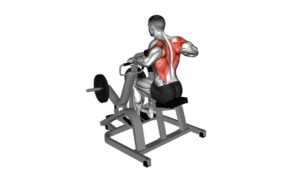Lever Low Row (Plate Loaded) – Video Exercise Guide & Tips

Are you looking to strengthen your back muscles and improve your overall upper body strength? Then the lever low row (plate loaded) exercise is perfect for you!
Watch This Exercise Video
In this video exercise guide, we'll show you the proper form and technique to get the most out of this exercise. We'll also highlight common mistakes to avoid and provide variations and progressions to keep challenging yourself.
Get ready to maximize your results and achieve your fitness goals with this effective exercise!
Key Takeaways
- Lever Low Row targets multiple muscle groups in the back, promoting muscle growth and strength through a pulling motion.
- Proper form and technique are crucial, including maintaining good posture, engaging core muscles, and initiating movement from the back muscles.
- Common mistakes to avoid include using excessive weight, rounding the back, relying on momentum, and prioritizing biceps over back muscles.
- Variations and progressions, such as different grips and hand positions, can be incorporated to target specific muscles in the back and increase the challenge.
Benefits of Lever Low Row
Discover the benefits of the Lever Low Row for a stronger back and improved posture. The Lever Low Row is an effective exercise that targets multiple muscle groups in your back, including the latissimus dorsi, rhomboids, and trapezius. By using a pulling motion, this exercise activates these muscles, promoting muscle growth and strength.
One of the key benefits of the Lever Low Row is its ability to improve muscle activation. As you perform the exercise, you engage your back muscles, resulting in increased strength and stability. This not only enhances your overall athletic performance but also helps prevent injuries by strengthening the muscles that support your spine.
Another advantage of the Lever Low Row is its impact on posture. Many people nowadays spend long hours sitting, which can lead to poor posture and back pain. By incorporating this exercise into your routine, you can strengthen the muscles responsible for maintaining proper posture. This can alleviate back pain and improve your overall posture, leading to a more confident and upright stance.
Proper Form and Technique
To perform the Lever Low Row exercise with proper form and technique, position yourself on the machine and grasp the handles firmly. Here are some key tips to ensure you're performing the exercise correctly:
- Maintain good posture: Keep your back straight, shoulders pulled back, and chest out. Avoid rounding your shoulders or hunching forward, as this can put unnecessary strain on your back.
- Engage your core: Before beginning the movement, activate your core muscles by pulling your belly button towards your spine. This will help stabilize your body throughout the exercise.
- Initiate the movement from your back muscles: As you pull the handles towards your body, focus on engaging your back muscles, particularly your lats and rhomboids. Avoid relying too much on your arms or shoulders to perform the movement.
- Control the weight: Lower the weight slowly and under control, resisting the urge to let it drop. This will ensure that you're effectively targeting your back muscles and minimizing the risk of injury.
Common misconceptions: One common misconception is that the Lever Low Row primarily targets the biceps. While the biceps do play a secondary role, the main focus of this exercise is on the back muscles, particularly the lats.
Muscle activation: The Lever Low Row primarily activates the lats, rhomboids, and posterior deltoids. It also engages the biceps, forearms, and core muscles to a lesser extent. By focusing on proper form and technique, you can maximize muscle activation and achieve optimal results from this exercise.
Common Mistakes to Avoid
Avoidance of common mistakes is crucial when performing the Lever Low Row exercise. To ensure you're getting the most out of this exercise and minimizing the risk of injury, it's important to pay attention to proper technique.
One common mistake to avoid is using too much weight. While it may be tempting to load up the machine with heavy plates, using excessive weight can compromise your form and put unnecessary strain on your muscles and joints. Instead, start with a weight that allows you to maintain proper form throughout the entire range of motion.
Another mistake to avoid is rounding your back. It's important to keep your back straight and your core engaged throughout the exercise. Rounding your back can lead to spinal compression and increase the risk of injury. Focus on keeping your chest lifted and your shoulders pulled back.
Lastly, avoid using momentum to complete the movement. The Lever Low Row exercise is meant to target your back muscles, so it's important to use controlled and deliberate movements. Avoid swinging your body or using momentum to pull the weight. Instead, focus on squeezing your shoulder blades together and using your back muscles to initiate the movement.
Variations and Progressions
To explore variations and progressions of the Lever Low Row exercise, you can incorporate different grips and hand positions to target specific muscles in your back. Here are some advanced variations and muscle activation techniques you can try:
- Narrow Underhand Grip: Place your hands close together on the handles with an underhand grip. This targets the lower lats and biceps more intensely.
- Wide Overhand Grip: Take a wider grip on the handles with an overhand grip. This emphasizes the upper back muscles and rear delts.
- Alternating Grip: Use an alternating grip, with one hand in an overhand position and the other in an underhand position. This helps to engage your stabilizer muscles and improve grip strength.
- Single-arm Row: Perform the exercise using only one arm at a time. This increases the challenge and allows for better isolation of the targeted muscles.
Tips for Maximizing Results
To maximize your results with the Lever Low Row exercise, focus on maintaining proper form and gradually increasing the resistance to challenge your back muscles. In addition to these exercise-specific tips, there are also nutrition and recovery strategies that can help you maximize your results.
When it comes to nutrition, it's important to fuel your body with the right nutrients to support your muscle growth and recovery. Make sure you're consuming enough protein to promote muscle repair and growth. Incorporate lean sources of protein such as chicken, fish, tofu, or beans into your meals. Additionally, include a variety of fruits, vegetables, whole grains, and healthy fats in your diet to provide your body with the necessary vitamins and minerals.
Recovery is a crucial aspect of maximizing your results. Make sure you're getting enough sleep, as this is when your muscles repair and grow. Aim for 7-9 hours of quality sleep each night. Incorporate rest days into your workout routine to allow your muscles time to recover. Additionally, consider incorporating activities such as yoga or stretching to improve flexibility and aid in muscle recovery.
Frequently Asked Questions
What Is the Recommended Weight or Resistance for Beginners to Start With on the Lever Low Row Exercise?
To start with the lever low row exercise, beginners should use a weight or resistance that challenges them but still allows for proper form. The recommended weight may vary depending on your strength and fitness level.
If you don't have access to a plate loaded machine, a resistance band can be used as an alternative.
It's important to start light and gradually increase the weight or resistance as you get stronger and more comfortable with the exercise.
Can the Lever Low Row Exercise Be Performed Using a Resistance Band Instead of a Plate-Loaded Machine?
Yes, you can modify the lever low row exercise by using a resistance band instead of a plate-loaded machine. This modification allows for a portable and convenient option for resistance training.
The benefits of the lever low row exercise include targeting the muscles in your upper back, shoulders, and arms while also improving your posture and grip strength.
Incorporating a resistance band into this exercise can add variety to your workout routine and help you achieve your fitness goals.
How Frequently Should the Lever Low Row Exercise Be Performed in a Weekly Workout Routine?
To get the most out of your workouts, it's important to know the recommended frequency for performing the lever low row exercise. The frequency will depend on your fitness goals and overall workout routine.
It's generally recommended to include the lever low row exercise in your weekly workout routine at least 2-3 times. However, it's always a good idea to consult with a fitness professional to determine the best frequency and variations of the lever low row for your specific needs.
Are There Any Specific Muscle Groups That Are Targeted More With the Lever Low Row Exercise Compared to Other Rowing Exercises?
When it comes to the lever low row exercise, there are specific muscle groups that are targeted more compared to other rowing exercises. This exercise is great for muscle activation in your back, especially the latissimus dorsi and rhomboids. It also works your biceps, rear deltoids, and traps.
The lever low row exercise offers variations to target different muscle groups, such as a narrow grip for more focus on the biceps or a wide grip for a wider back activation.
Can the Lever Low Row Exercise Help Improve Posture and Alleviate Back Pain?
Yes, the lever low row exercise can help improve your posture and alleviate back pain.
By targeting the muscles in your upper back and shoulders, this exercise strengthens and stabilizes your spine.
It also helps to correct imbalances and promotes proper alignment, which can relieve tension and discomfort in your back.
Incorporating the lever low row into your workout routine can be beneficial for improving your posture and reducing back pain.
Conclusion
In conclusion, the lever low row exercise is a highly effective way to target and strengthen your back muscles.
By maintaining proper form and avoiding common mistakes, you can maximize your results and avoid injury.
Additionally, incorporating variations and progressions into your routine can help challenge your muscles and keep your workouts exciting.
Remember to consult with a fitness professional to ensure you're using the correct technique and weight for your fitness level.
Keep pushing yourself and enjoy the benefits of this powerful exercise.

Author
Years ago, the spark of my life’s passion ignited in my mind the moment I stepped into the local gym for the first time. The inaugural bead of perspiration, the initial endeavor, the very first surge of endorphins, and a sense of pride that washed over me post-workout marked the beginning of my deep-seated interest in strength sports, fitness, and sports nutrition. This very curiosity blossomed rapidly into a profound fascination, propelling me to earn a Master’s degree in Physical Education from the Academy of Physical Education in Krakow, followed by a Sports Manager diploma from the Jagiellonian University. My journey of growth led me to gain more specialized qualifications, such as being a certified personal trainer with a focus on sports dietetics, a lifeguard, and an instructor for wellness and corrective gymnastics. Theoretical knowledge paired seamlessly with practical experience, reinforcing my belief that the transformation of individuals under my guidance was also a reflection of my personal growth. This belief holds true even today. Each day, I strive to push the boundaries and explore new realms. These realms gently elevate me to greater heights. The unique combination of passion for my field and the continuous quest for growth fuels my drive to break new ground.







